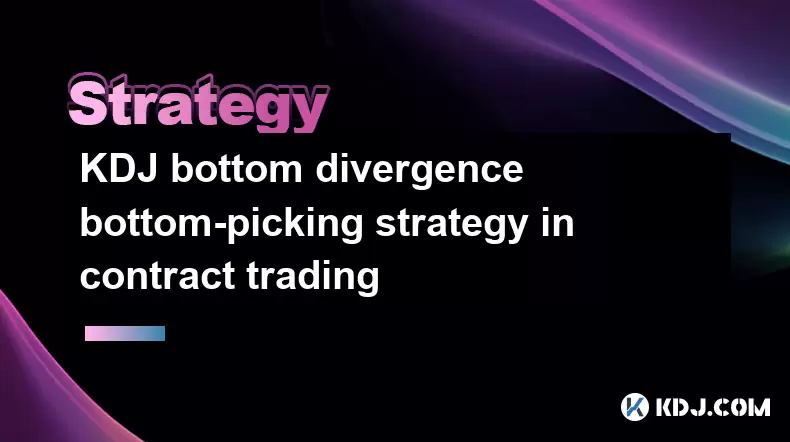-
 bitcoin
bitcoin $120167.907534 USD
1.27% -
 ethereum
ethereum $4468.611945 USD
2.53% -
 xrp
xrp $3.013607 USD
1.80% -
 tether
tether $1.000549 USD
-0.01% -
 bnb
bnb $1092.592149 USD
6.28% -
 solana
solana $231.391244 USD
4.59% -
 usd-coin
usd-coin $0.999699 USD
-0.04% -
 dogecoin
dogecoin $0.259020 USD
4.30% -
 tron
tron $0.342747 USD
0.34% -
 cardano
cardano $0.860977 USD
1.07% -
 hyperliquid
hyperliquid $50.155412 USD
5.34% -
 chainlink
chainlink $22.637678 USD
0.46% -
 ethena-usde
ethena-usde $1.000528 USD
-0.07% -
 avalanche
avalanche $30.613779 USD
-0.07% -
 stellar
stellar $0.403905 USD
0.94%
KDJ bottom divergence bottom-picking strategy in contract trading
The KDJ bottom divergence strategy uses the KDJ indicator to spot potential reversals in cryptocurrency futures trading, helping traders enter long positions at favorable prices.
Jun 02, 2025 at 12:07 pm

KDJ bottom divergence bottom-picking strategy in contract trading is a technical analysis method used by traders to identify potential buying opportunities in the cryptocurrency market. This strategy involves using the KDJ indicator, a momentum oscillator, to spot divergences that signal a potential reversal from a downtrend to an uptrend. In this article, we will explore the intricacies of the KDJ indicator, how to identify bottom divergences, and how to apply this strategy effectively in contract trading.
Understanding the KDJ Indicator
The KDJ indicator is a technical analysis tool derived from the stochastic oscillator. It consists of three lines: the K line, the D line, and the J line. The K line is the fastest, the D line is a moving average of the K line, and the J line is calculated as 3K - 2D. The KDJ indicator oscillates between 0 and 100 and is used to gauge the momentum of price movements.
The KDJ indicator is particularly useful in overbought and oversold conditions. When the KDJ lines are above 80, the market is considered overbought, and when they are below 20, the market is considered oversold. Traders often look for crossovers and divergences to make trading decisions.
Identifying Bottom Divergences
A bottom divergence occurs when the price of a cryptocurrency makes a lower low, but the KDJ indicator makes a higher low. This discrepancy suggests that the downward momentum is weakening, and a potential reversal may be imminent. Bottom divergences are key signals for traders looking to enter long positions.
To identify a bottom divergence, follow these steps:
- Monitor the price action: Look for a clear downtrend where the price is making lower lows.
- Observe the KDJ indicator: Simultaneously, check if the KDJ lines are making higher lows.
- Confirm the divergence: Ensure that the divergence is significant enough to warrant a trading decision.
Applying the KDJ Bottom Divergence Strategy in Contract Trading
Contract trading, also known as futures trading, involves buying or selling contracts that obligate the trader to buy or sell a specific amount of a cryptocurrency at a predetermined price on a future date. The KDJ bottom divergence strategy can be particularly effective in this context because it allows traders to enter positions at potentially favorable prices.
To apply the KDJ bottom divergence strategy in contract trading, consider the following steps:
- Select a suitable cryptocurrency: Choose a cryptocurrency with sufficient liquidity and volatility to ensure that the KDJ indicator provides reliable signals.
- Set up the KDJ indicator on your trading platform: Ensure that your trading platform supports the KDJ indicator and that it is configured correctly.
- Identify a bottom divergence: Follow the steps outlined above to spot a bottom divergence on the chart.
- Enter a long position: Once a bottom divergence is confirmed, enter a long position by buying a futures contract.
- Set stop-loss and take-profit levels: To manage risk, set a stop-loss order below the recent low and a take-profit order at a level that reflects your profit target.
Risk Management in KDJ Bottom Divergence Trading
Effective risk management is crucial when applying the KDJ bottom divergence strategy in contract trading. Risk management involves setting appropriate stop-loss orders, managing position sizes, and understanding the leverage used in futures trading.
To manage risk effectively:
- Determine your risk tolerance: Assess how much capital you are willing to risk on each trade.
- Calculate position sizes: Use your risk tolerance to determine the size of your positions.
- Set stop-loss orders: Always set a stop-loss order to limit potential losses.
- Monitor leverage: Be aware of the leverage used in futures trading, as it can amplify both gains and losses.
Practical Example of KDJ Bottom Divergence Strategy
Let's consider a practical example of how to apply the KDJ bottom divergence strategy in contract trading. Suppose you are trading Bitcoin futures and notice the following scenario:
- Price action: Bitcoin has been in a downtrend, making a new low at $25,000.
- KDJ indicator: The KDJ lines have made a higher low at the same time, indicating a bottom divergence.
- Entry point: You decide to enter a long position at $25,500, just above the recent low.
- Stop-loss: You set a stop-loss order at $24,500, just below the recent low.
- Take-profit: You set a take-profit order at $27,000, reflecting your profit target.
In this example, you have applied the KDJ bottom divergence strategy to enter a long position in Bitcoin futures, with appropriate risk management measures in place.
Technical Considerations and Limitations
While the KDJ bottom divergence strategy can be effective, it is important to consider its technical limitations. Technical considerations include the need for confirmation from other indicators, the potential for false signals, and the impact of market volatility.
To mitigate these limitations:
- Use additional indicators: Combine the KDJ indicator with other technical indicators, such as moving averages or the Relative Strength Index (RSI), to confirm signals.
- Be cautious of false signals: Not all divergences lead to reversals, so be prepared to exit trades if the expected reversal does not materialize.
- Account for market volatility: High volatility can lead to erratic signals, so adjust your trading strategy accordingly.
Frequently Asked Questions
Q1: Can the KDJ bottom divergence strategy be used in other types of trading besides contract trading?A1: Yes, the KDJ bottom divergence strategy can be applied to spot trading and other types of trading where technical analysis is used. However, the specific entry and exit points, as well as risk management techniques, may differ depending on the trading context.
Q2: How often should I check the KDJ indicator for divergences?A2: The frequency of checking the KDJ indicator depends on your trading style. For short-term traders, checking the indicator multiple times a day may be necessary, while long-term traders might check it less frequently, such as daily or weekly.
Q3: Are there any specific timeframes that work best with the KDJ bottom divergence strategy?A3: The KDJ bottom divergence strategy can be applied to various timeframes, but it tends to be more reliable on shorter timeframes, such as 1-hour or 4-hour charts, due to the sensitivity of the KDJ indicator to price movements.
Q4: How can I improve the accuracy of the KDJ bottom divergence strategy?A4: To improve the accuracy of the KDJ bottom divergence strategy, consider using it in conjunction with other technical indicators, such as trend lines, support and resistance levels, and volume analysis, to confirm signals and reduce the likelihood of false positives.
Disclaimer:info@kdj.com
The information provided is not trading advice. kdj.com does not assume any responsibility for any investments made based on the information provided in this article. Cryptocurrencies are highly volatile and it is highly recommended that you invest with caution after thorough research!
If you believe that the content used on this website infringes your copyright, please contact us immediately (info@kdj.com) and we will delete it promptly.
- BlockDAG, DOGE, HYPE Sponsorship: Crypto Trends Shaping 2025
- 2025-10-01 00:25:13
- Deutsche Börse and Circle: A StableCoin Adoption Powerhouse in Europe
- 2025-10-01 00:25:13
- BlockDAG's Presale Buzz: Is It the Crypto to Watch in October 2025?
- 2025-10-01 00:30:13
- Bitcoin, Crypto, and IQ: When Genius Meets Digital Gold?
- 2025-10-01 00:30:13
- Stablecoins, American Innovation, and Wallet Tokens: The Next Frontier
- 2025-10-01 00:35:12
- NBU, Coins, and Crypto in Ukraine: A New Yorker's Take
- 2025-10-01 00:45:14
Related knowledge

Practical parameter settings for a Bitcoin multi-timeframe moving average system
Sep 18,2025 at 10:54pm
Optimizing Timeframe Combinations for Bitcoin Trading1. Selecting appropriate timeframes is crucial when building a multi-timeframe moving average sys...

How can I filter out false breakouts in Dogecoin high-frequency trading?
Sep 22,2025 at 01:00am
Understanding False Breakouts in Dogecoin Trading1. A false breakout occurs when Dogecoin's price appears to move beyond a defined support or resistan...

Techniques for identifying tops and bottoms in the Bitcoin on-chain NVT model
Sep 20,2025 at 07:54pm
Understanding the NVT Model in Bitcoin Analysis1. The Network Value to Transactions (NVT) ratio is often described as the 'P/E ratio' of the cryptocur...

What does the surge in open interest in Bitcoincoin futures mean?
Sep 20,2025 at 11:18pm
Understanding the Surge in Dogecoin Futures Open Interest1. A surge in open interest within Dogecoin futures indicates a growing number of active cont...

How can I use the Ethereum USDT premium to gauge market sentiment?
Sep 18,2025 at 11:55pm
Understanding the Ethereum USDT Premium1. The Ethereum USDT premium refers to the price difference between USDT (Tether) traded on Ethereum-based plat...

What should I do if Ethereum staking yields decline?
Sep 20,2025 at 06:18am
Understanding the Causes Behind Declining Ethereum Staking Yields1. The Ethereum network transitioned to a proof-of-stake consensus mechanism with the...

Practical parameter settings for a Bitcoin multi-timeframe moving average system
Sep 18,2025 at 10:54pm
Optimizing Timeframe Combinations for Bitcoin Trading1. Selecting appropriate timeframes is crucial when building a multi-timeframe moving average sys...

How can I filter out false breakouts in Dogecoin high-frequency trading?
Sep 22,2025 at 01:00am
Understanding False Breakouts in Dogecoin Trading1. A false breakout occurs when Dogecoin's price appears to move beyond a defined support or resistan...

Techniques for identifying tops and bottoms in the Bitcoin on-chain NVT model
Sep 20,2025 at 07:54pm
Understanding the NVT Model in Bitcoin Analysis1. The Network Value to Transactions (NVT) ratio is often described as the 'P/E ratio' of the cryptocur...

What does the surge in open interest in Bitcoincoin futures mean?
Sep 20,2025 at 11:18pm
Understanding the Surge in Dogecoin Futures Open Interest1. A surge in open interest within Dogecoin futures indicates a growing number of active cont...

How can I use the Ethereum USDT premium to gauge market sentiment?
Sep 18,2025 at 11:55pm
Understanding the Ethereum USDT Premium1. The Ethereum USDT premium refers to the price difference between USDT (Tether) traded on Ethereum-based plat...

What should I do if Ethereum staking yields decline?
Sep 20,2025 at 06:18am
Understanding the Causes Behind Declining Ethereum Staking Yields1. The Ethereum network transitioned to a proof-of-stake consensus mechanism with the...
See all articles










































































